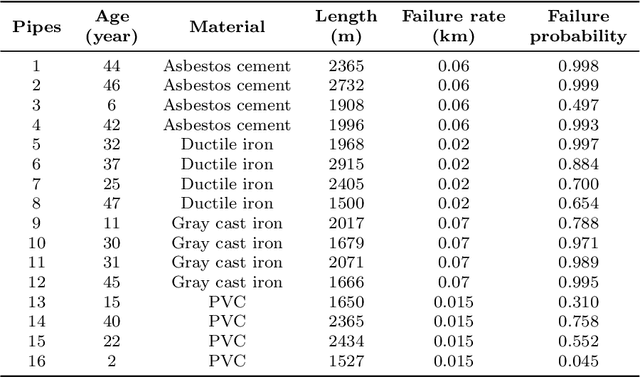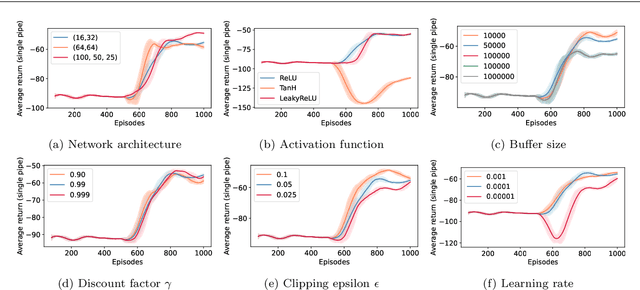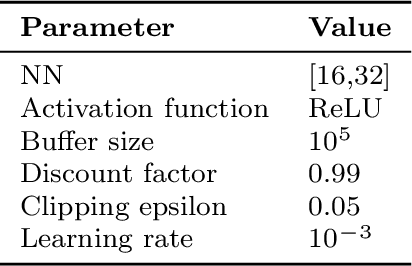Zaharah A. Bukhsh
A Maintenance Planning Framework using Online and Offline Deep Reinforcement Learning
Aug 01, 2022



Abstract:Cost-effective asset management is an area of interest across several industries. Specifically, this paper develops a deep reinforcement learning (DRL) solution to automatically determine an optimal rehabilitation policy for continuously deteriorating water pipes. We approach the problem of rehabilitation planning in an online and offline DRL setting. In online DRL, the agent interacts with a simulated environment of multiple pipes with distinct length, material, and failure rate characteristics. We train the agent using deep Q-learning (DQN) to learn an optimal policy with minimal average costs and reduced failure probability. In offline learning, the agent uses static data, e.g., DQN replay data, to learn an optimal policy via a conservative Q-learning algorithm without further interactions with the environment. We demonstrate that DRL-based policies improve over standard preventive, corrective, and greedy planning alternatives. Additionally, learning from the fixed DQN replay dataset surpasses the online DQN setting. The results warrant that the existing deterioration profiles of water pipes consisting of large and diverse states and action trajectories provide a valuable avenue to learn rehabilitation policies in the offline setting without needing a simulator.
ProcessTransformer: Predictive Business Process Monitoring with Transformer Network
Apr 01, 2021



Abstract:Predictive business process monitoring focuses on predicting future characteristics of a running process using event logs. The foresight into process execution promises great potentials for efficient operations, better resource management, and effective customer services. Deep learning-based approaches have been widely adopted in process mining to address the limitations of classical algorithms for solving multiple problems, especially the next event and remaining-time prediction tasks. Nevertheless, designing a deep neural architecture that performs competitively across various tasks is challenging as existing methods fail to capture long-range dependencies in the input sequences and perform poorly for lengthy process traces. In this paper, we propose ProcessTransformer, an approach for learning high-level representations from event logs with an attention-based network. Our model incorporates long-range memory and relies on a self-attention mechanism to establish dependencies between a multitude of event sequences and corresponding outputs. We evaluate the applicability of our technique on nine real event logs. We demonstrate that the transformer-based model outperforms several baselines of prior techniques by obtaining on average above 80% accuracy for the task of predicting the next activity. Our method also perform competitively, compared to baselines, for the tasks of predicting event time and remaining time of a running case
Damage detection using in-domain and cross-domain transfer learning
Feb 07, 2021



Abstract:We investigate the capabilities of transfer learning in the area of structural health monitoring. In particular, we are interested in damage detection for concrete structures. Typical image datasets for such problems are relatively small, calling for the transfer of learned representation from a related large-scale dataset. Past efforts of damage detection using images have mainly considered cross-domain transfer learning approaches using pre-trained ImageNet models that are subsequently fine-tuned for the target task. However, there are rising concerns about the generalizability of ImageNet representations for specific target domains, such as for visual inspection and medical imaging. We, therefore, propose a combination of in-domain and cross-domain transfer learning strategies for damage detection in bridges. We perform comprehensive comparisons to study the impact of cross-domain and in-domain transfer, with various initialization strategies, using six publicly available visual inspection datasets. The pre-trained models are also evaluated for their ability to cope with the extremely low-data regime. We show that the combination of cross-domain and in-domain transfer persistently shows superior performance even with tiny datasets. Likewise, we also provide visual explanations of predictive models to enable algorithmic transparency and provide insights to experts about the intrinsic decision-logic of typically black-box deep models.
 Add to Chrome
Add to Chrome Add to Firefox
Add to Firefox Add to Edge
Add to Edge